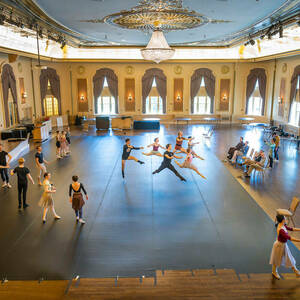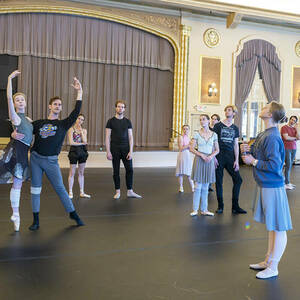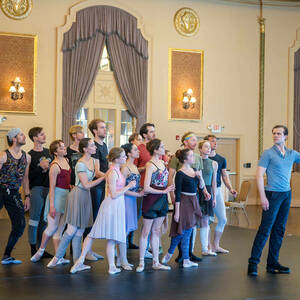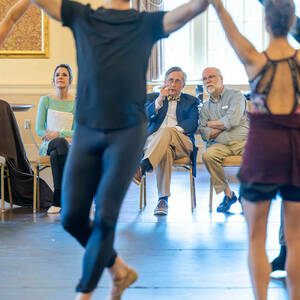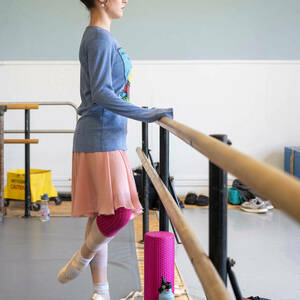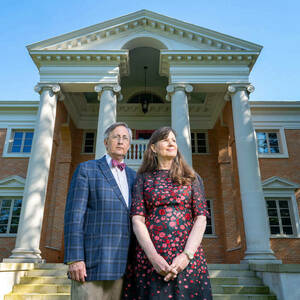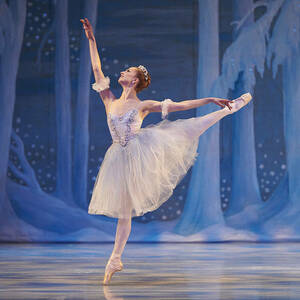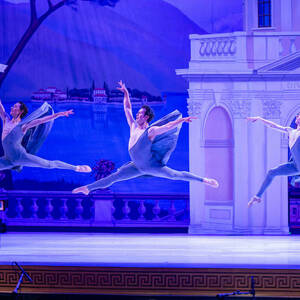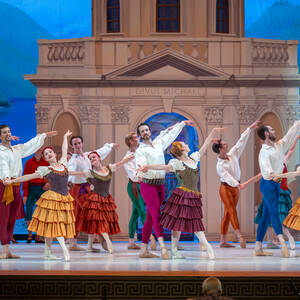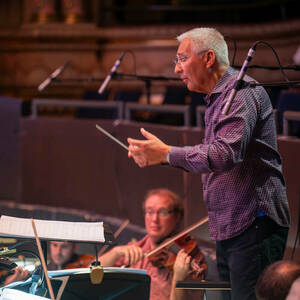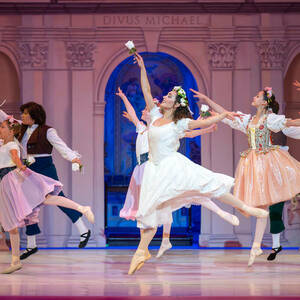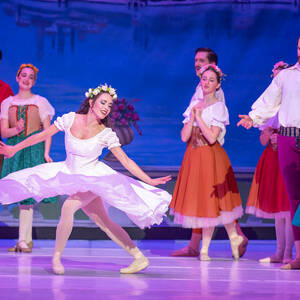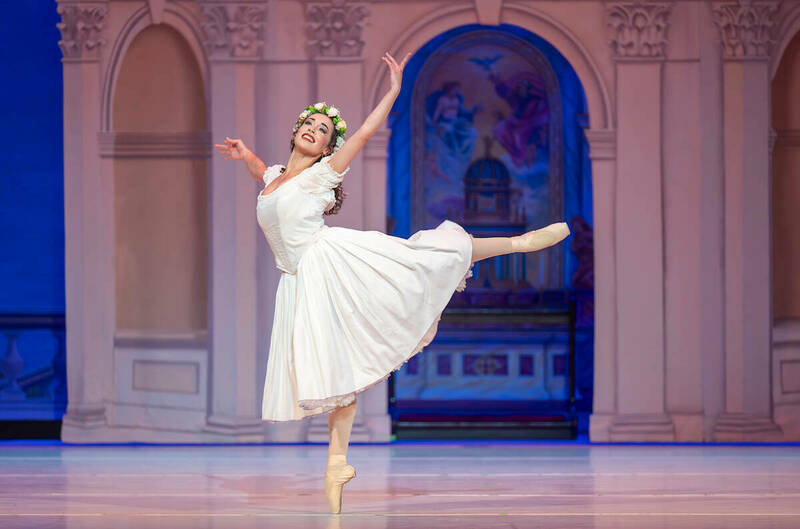 Leah McFadden, a principal dancer with the Colorado Ballet, rehearses for the title role of the ballet inspired by the life of her friend, Raffaella Stroik. Photography by Barbara Johnston.
Leah McFadden, a principal dancer with the Colorado Ballet, rehearses for the title role of the ballet inspired by the life of her friend, Raffaella Stroik. Photography by Barbara Johnston.
- A Fairy Tale for Raffaella
- Raffaella, Aloft
- Stories Unspoken that Steal Your Heart
When ballet tells a story, it keeps things simple. Enchanted sets and backdrops, evocative, beautiful costumes. Just a few main characters. The rest is movement and music, sweeping up audiences into the full range of human emotion.
“Typically,” says Claire Kretzschmar, a former New York City Ballet soloist and the choreographer of Raffaella, a new narrative ballet premiering at South Bend’s Morris Performing Arts Center June 29-30, “we don’t speak with our mouths. And I say ‘typically,’ because maybe there’s some new pieces out there where they actually speak as they dance.”
Although Kretzschmar is well versed in the modes and aspirations of contemporary ballet, Raffaella harkens to an older standard. Start with the fact that it seeks to tell a story at all. Trained in the dynamic — and often nonnarrative — school of famed ballet innovator George Balanchine, Kretzschmar fell in love with the way “music and movement speak together.”
“I think there’s something very pure about that, and very powerful, that stories can be conveyed through the physical body,” she says. “But of course, a body is a body and a soul together. So, you see the physical body, but how we shape our physicality can convey what’s going on in a character’s mind and heart.”
“One of the things I really love about ballet,” adds former dancer and Raffaella set designer Gabrielle Stroik Johnson ’13, is “you don’t have to be an expert in ballet to see the beauty of it.”
So much comes down to acting. “Maybe a little bit of pantomime, the gestures,” Johnson explains, but it’s also the sensible psychology, and even the speed, of the dancers’ movements. “They’re usually very simple stories where the plot can be . . . understood visually.”
That’s the intention driving Raffaella, a fairytale ballet based on the hope-filled life of Johnson’s late sister, Raffaella Maria Stroik, a professional ballerina who died unexpectedly while hiking during a personal religious retreat in November 2018.
Raffaella loved fairy tales, says their father, Duncan Stroik, a Notre Dame professor of architecture and co-producer of the new ballet. “She always wanted to be in the classics. If she had a choice — contemporary or classical? Always classical,” he says.
After Raffaella Stroik died, the idea to create such a ballet in her honor didn’t come right away. But after months of prayer and discussion among family and friends, and above all with his wife, Ruth, Duncan felt his daughter was asking him to do it.
“It is in her honor, and it’s named after her, but it’s really for other people. Like any art form, it’s a gift. And I thought, what better could you do for a little girl who loved ballet, who wanted to marry a prince, but to do a new ballet about marrying a prince?”
Raffaella tells the story of a girl born to dance who encounters potent choices between good and evil along life’s path. In a way, the story spans everything, from the realm of simple, human gestures like the pick-me-up gift of a rose offered in friendship, or the way we respond to competition and jealousy, to the great celestial battle between angels and demons.
Inspired by their daughter’s belief that “beauty will save the world,” the Stroiks reached out in 2019 for advice and support, and the response from the ballet community — starting with the Indiana University School of Music, Raffaella Stroik’s alma mater — was heartening.
Soon the couple found their way to composer Michael Kurek, an emeritus professor of music at Vanderbilt University, who in 2022 was named composer laureate of Tennessee. Kurek’s recently recorded second symphony, Tales from the Realm of Faerie, hinted at the perfection of the match. But just as important as their common love of fairy stories was the deeper, shared belief in music’s power to tell stories without words. Further, much like the quixotic idea of producing an original, fairytale ballet, Kurek himself is something of a rarity. The Stroiks were looking for a neotraditional composer, he says. “I may be the only one alive.”
“Neotraditional” means that unlike most contemporary orchestral composers, Kurek writes tonal music, in which tension builds as a musical line moves away from its tonic note and resolves by returning to it. He writes memorable melodies, albeit “serpentine” and “asymmetrical” ones, and harmonies that may have more in common with jazz than with, say, Mozart. Trained — and successful — in the atonal music of the 20th century, the younger Kurek discovered he could no longer listen to his own compositions. So much aimless wandering, he felt. “And I believe that life has a purpose,” he says. “That we’re on a journey in our lives with many subplots and major plots, and with the ultimate goal of heaven. So why shouldn’t the music be the same?”
These days, Kurek writes music he himself would want to hear: “I imagine a whole audience of me yelling, ‘Bravo!’”
Tired, too, of writing short “musical poems” and drawn to the narrative structures and dimensions he finds in Beethoven and Brahms, Kurek had longed to write “a musical novel” on the level of a symphony. Ballet introduced new challenges. Uncertain where the yet notional Raffaella would be performed, he composed for a standard orchestra of about 90 musicians. The Morris’ pit accommodates a 42-piece ensemble, which meant fewer brass and woodwinds, half the strings and no harp.
“If you want a big, Tchaikovsky, Swan Lake, lush sound, you need more strings. So, what I’ll be doing is having a keyboard play along with the strings, using the string sound,” he explains. Rather than playing directly into the theater’s sound system, the synthesizer will project sound along with the orchestra, and the microphones will pick up the blend of them all together. “And this is an old trick from Hollywood, actually.”
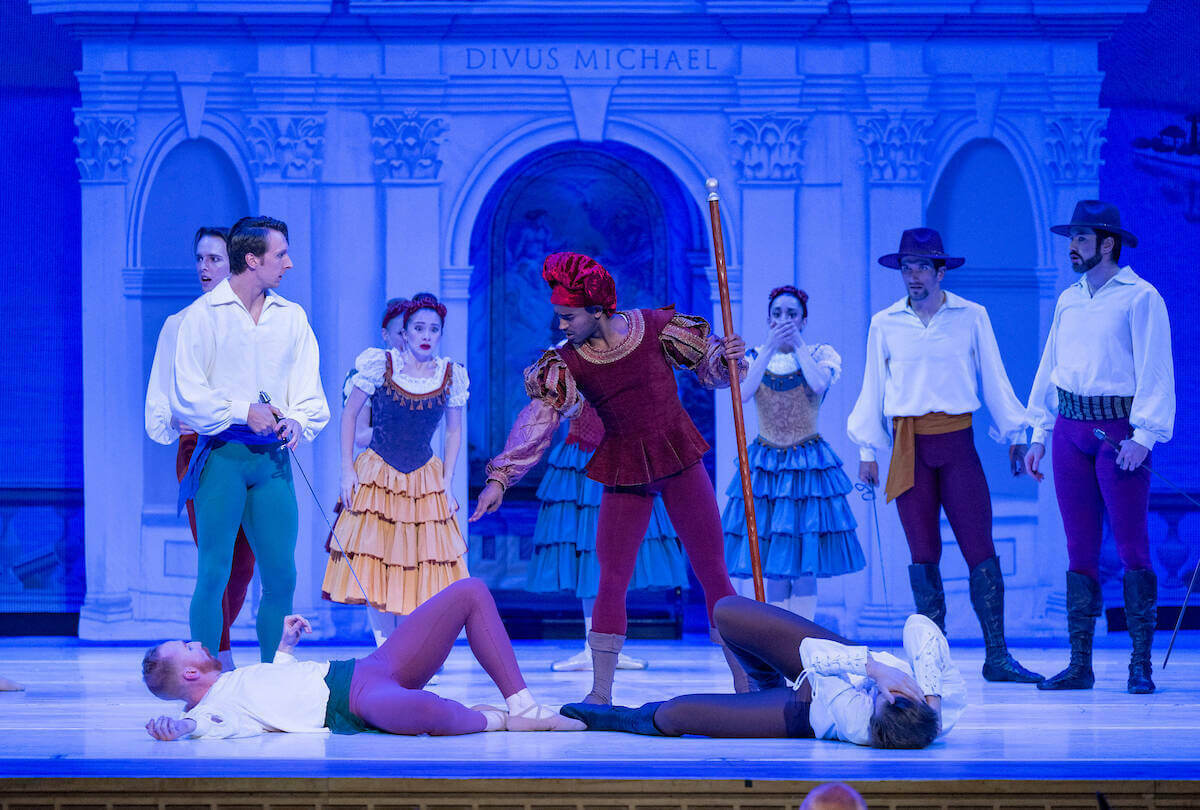
By the time the Stroiks enlisted Kretzschmar to design the dance, Kurek’s composition was about two-thirds finished. The ensuing collaboration, he says, helped them hone themes, shape characters, even eliminate certain scenes as together the choreographer and the composer refined the basic story.
Each character has his or her own theme, in many cases based on someone important in Raffaella Stroik’s life. For instance, the Emerald Queen, the title character’s main tutor in act two, is inspired by Violette Verdy, the legendary French ballerina for whom Balanchine designed the “Emeralds” movement in his unnamed, 1967 ballet widely remembered as Jewels. Ironically, Jewels was a revolutionary piece, counted today among the first full-length, abstract ballets. Nearly 50 years after its debut, when her students performed the ballet at Indiana University in Bloomington, Verdy chose Raffaella to dance the part that the Russian American master had created for her.
“Raffi felt [Verdy] had “developed her as an artist exponentially,” recalls Isabella LaFreniere, a principal dancer of the New York City Ballet who was a childhood friend of Raffaella and who also studied “the Balanchine aesthetic” under Verdy.
Channeled through Kretzschmar’s artistic vision, that aesthetic distills into Raffaella mainly as a fidelity to the “truth” of the music. When she danced for the NYCB, the company Balanchine co-founded in the 1940s, she says, “I got to experience both in my mind and in my body what great choreography feels like, and what musicality danced feels like.”
“And I’m constantly asking, what is this music asking me to choreograph?” she adds. “I really do look to the music as the template and the guide for the choreography. And sometimes I don’t figure it out right away.”
“What Claire and I both agreed on is, above all, it should simply be beautiful,” in honor of Raffaella, Kurek says. “And nothing more intellectual than that. Just something simple. That’s what it’s about. Beauty, and a mandate to say, ‘Do something beautiful.’”
In designing the set and painting the backdrops, Johnson, trained as an architect, pursued that same vision. Among her sources of inspiration was Rome’s Porto del Popolo, the gate by which most pilgrims during the Renaissance received their first glimpse of the Eternal City.
She credits the idea to one of her younger sisters, Maddalena, a Notre Dame architecture student who had just finished her year of study in Rome. They were sitting in the “piazza of the people,” Johnson says, contemplating its monumental scale and the pair of churches at its southern end, one regarded as the “church of the artists” and the other dedicated to Our Lady of the Miracle, and the idea came forth. What about this? Another minor epiphany in the ballet’s collective creative adventure.
“I’m awestruck by how this whole production is coming from the hearts of two loving parents,” says Kretzschmar.
“I’m just at this moment grateful . . . we can have a moment to remember Rafaella, to enjoy a ballet together on a summer night in South Bend, Indiana,” Ruth Stroik replies.
And the way to do that, adds LaFreniere, who was injured in June while preparing to tell her friend’s story in dance, is not to look for anything. Just sit back and take in a classic story told live and in person, but without words.
“What’s so special about art is it’s subjective,” LaFreniere says. “Everyone comes home with a different feeling, a different emotion, a different inspiration. And that’s why it’s so important, and still so relevant.”
John Nagy is managing editor of this magazine.
